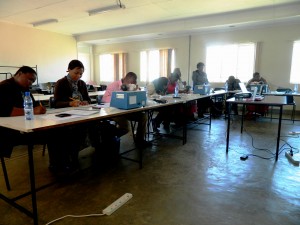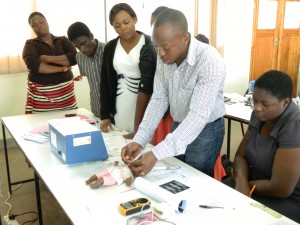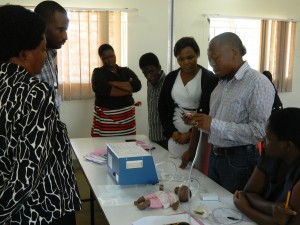These past few weeks have definitely given me a greater appreciation for the importance of project implementation and management, especially in the context of the CPAP Study. This week in particular, we had three different CPAP trainings going on. We had one for graduate students at the Kamuzu College of Nursing, one for district hospital coordinators hosted here at Queens, and one for nurses during a CPAP installation visit at Thyolo District Hospital.
Here’s a brief overview of what a training looks like:
- Introduction to CPAP as a treatment option
- Explanation of conditions appropriate for CPAP treatment
- Description and outcomes of the pilot study at Queens
- An explanation of assembly and cleaning of the machine
- Instruction on how to place a baby on CPAP
- Instructions on monitoring care, tracking progress, and weaning babies from CPAP when treatment is complete
- Explanation of the current study procedures and data that should be obtained during treatment
- Suggestions for talking to mothers about the benefits of CPAP treatment
The training itself is a mix of classroom instruction and observational periods on the wards, and the classroom portion combines presentations and videos with practical, hands-on experience with the CPAP machine.
Tanya and I helped prepare the training for district hospital coordinators here at Queens, and we had seven participants from five different hospitals attending. The hospitals included Machinga District Hospital, Thyolo District Hospital, Chiradzulu District Hospital, and Mulange District Hospital, marked on the map below:
District hospital coordinators are critical to effective CPAP implementation. District hospitals are much smaller than central hospitals like Queens, so oftentimes these hospitals are even more short-staffed and pressed for resources. By training coordinators, each hospital then has its own CPAP expert to be able to conduct further staff and clinician training when they return home to their district. All of the coordinators were engaged in the material, and it was neat to see how the simplicity of the bCPAP design makes it an approachable and exciting machine to learn about and train with.
Hospital coordinators during the instructional and practical training sessions.
However, no matter how simple or intuitive a design, this training also showed me that no machine can be successful without a full-force effort from a wide range of community members, nurses, clinicians, and policymakers. The amount of resources that go into planning, executing, and evaluating training shows that the quality of these trainings have been fundamental to the CPAP’s success thus far. The enthusiasm and effectiveness of the facilitator, pediatrician, and nurse running the program today were a powerful reminder that improving outcomes for patients comes from the dedicated professionals who commit to constant development and educational opportunities as much as it comes from the technology innovation itself.
Nurse Florence and Dr. Mzikamanda look on as trainers demonstrate how to select the appropriately sized tubing for infants on CPAP.


